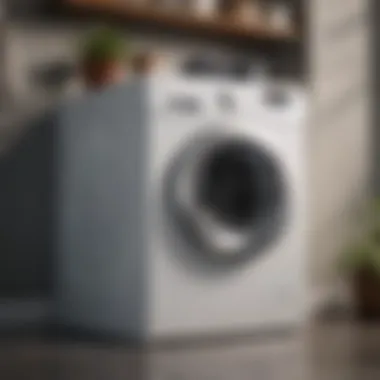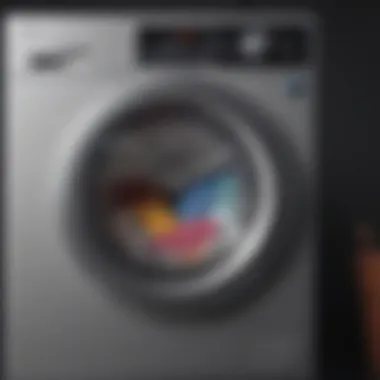Top Mid-Range Washing Machines: A Comprehensive Guide


Intro
Selecting a washing machine is no small task. It's not just about finding a model that cleans clothes; it involves understanding myriad features that can impact efficiency and performance. This guide will explore mid-range washing machines, which often strike an excellent balance between affordability and advanced features.
Mid-range options tend to provide solid performance without the hefty price tag associated with high-end models. They include essential functions, user-friendly controls, and various wash settings designed to cater to multiple fabric types and load sizes. Additionally, energy efficiency is a significant factor. Many mid-range machines are designed to consume less water and electricity, which can lead to notable savings on utility bills.
Throughout this guide, we will discuss the critical elements a consumer should consider when shopping for their next washing machine. This includes brand comparisons, user reviews, and helpful maintenance tips. By the end, readers should feel empowered to make an informed choice that aligns with their specific needs and budget.
Key Considerations
- Performance: The effectiveness of a washing machine in cleaning different types of fabrics.
- Features: Innovations like smart technology, various wash cycles, and capacity options.
- Value for Money: Understanding what is offered at each price point and its long-term benefits.
- Energy Efficiency: Assessing how models can save on water and electricity.
- Maintenance Tips: Practical advice on keeping your washing machine in optimal condition over time.
"Choosing wisely can lead to years of reliable washing and clean clothes, making the shopping process worthwhile."
This article provides valuable insights to streamline the selection process, ensuring you find a washing machine that fits your lifestyle while meeting your expectations.
Understanding Mid-Range Washing Machines
Mid-range washing machines occupy a significant niche in the appliance market, providing an ideal balance between affordability and advanced features. As appliances have become essential in modern households, understanding these machines is critical for making informed decisions. This section delves into the characteristics and benefits of mid-range washing machines, assisting consumers in navigating their options.
Definition and Market Overview
Mid-range washing machines are typically defined as machines that offer superior performance and a range of features compared to budget models but do not include the high-end technology found in premium models. Generally, they are priced between $500 and $1,200, which appeals to a wide audience, including families and young professionals.
The market for washing machines is vast, with various brands and models available. The mid-range segment has grown in popularity as consumers seek reliable products without overspending. Several manufacturers have focused on performance and energy efficiency, ensuring that users can do laundry effectively while saving money on utility bills.
Importance of Mid-Range Options
Opting for mid-range washing machines has several advantages. The significant benefit is the value for money they provide. Buyers can access features such as energy efficiency, diverse wash cycles, and greater load capacities that significantly enhance user experience. These features address everyday washing needs and work toward consumer convenience.
Mid-range options also offer a balance between cost and performance. For many households, investing in a machine that is both reliable and affordably priced is crucial. This segment allows users to enjoy modern technology without necessitating steep financial commitments.
Moreover, mid-range washing machines tend to have a better resale value than budget models. This makes them a wiser investment if consumers decide to upgrade in the future. As the market continues to evolve, the demand for these versatile machines remains strong, ensuring there are ample choices for diverse household needs.
"The right washing machine can significantly impact your daily routine, balancing performance with cost-effectiveness."
Key Features of Mid-Range Washing Machines
Understanding the key features of mid-range washing machines is critical for consumers looking for reliable performance without the premium price tag. Consumers should focus on attributes such as load capacity, spin speed variability, and energy efficiency ratings. These factors not only affect washing performance, but also play a significant role in the operational cost, sustainability, and suitability for diverse home needs.
Load Capacity
Load capacity is a fundamental characteristic that plays a pivotal role in a washing machine's performance. Generally, mid-range washing machines offer a load capacity between 4.5 to 5.5 cubic feet. This range is sufficient for small to medium-sized households, allowing users to wash a decent amount of laundry in one cycle.
The load size impacts how often you need to use the machine. A larger capacity can save time and energy, as it facilitates more laundry in fewer loads. On the other hand, if you frequently wash smaller loads, consider machines with a slightly smaller capacity. Additionally, it’s vital to balance load size with washing machine cycle types and efficiency to get the best performance.
Spin Speed Variability
Spin speed is another crucial feature, influencing the moisture level of clothes after they are washed. Most mid-range models offer a range of spin speeds, commonly ranging from 600 to 1200 RPM. A higher spin speed removes more water, which can reduce drying time significantly.
When selecting a washing machine, pay attention to variability in spin speeds. Some models provide multiple options which allow consumers to select a cycle tailored for different types of fabric. This is particularly important for delicate fabrics that might require a gentler spin. Overall, choosing a machine with sufficient spin speed variability can enhance the user’s laundry experience and fabric care.
Energy Efficiency Ratings
Energy efficiency ratings are essential for understanding the operational cost of washing machines. Mid-range washing machines typically come with Energy Star ratings, which indicate that they meet specific energy efficiency guidelines. These ratings not only help to minimize energy consumption but also reduce electricity bills over time.


Choosing an energy-efficient model can lead to significant savings in utility costs. For families or frequent users, the costs add up quickly. Moreover, energy-efficient machines often incorporate technologies that contribute to better washing performance. This helps in preserving resources while providing effective cleaning solutions.
"Choosing a mid-range washing machine with the right features can make a significant different in your laundry routine and expenses."
Popular Brands in the Mid-Range Segment
In the ever-evolving landscape of household appliances, the choice of brand plays a critical role in determining both the quality and reliability of mid-range washing machines. Well-established brands not only offer a range of features but also contribute significantly to consumer trust. This section focuses on three prominent companies: LG, Samsung, and Whirlpool. Each brand has carved a niche in the mid-range segment, providing products that balance performance, design, and affordability.
LG
LG has a longstanding reputation for innovating within the appliance industry. Their mid-range washing machines are characterized by advanced technology, energy efficiency, and user-friendly designs. One notable feature is the TurboWash technology, which shortens wash times without compromising cleaning performance. LG machines are also equipped with Smart Diagnosis, enabling users to identify and troubleshoot issues with minimal hassle.
The brand emphasizes customer satisfaction, often reflected in user reviews praising both efficiency and durability. Furthermore, LG's commitment to sustainable practices aligns with growing consumer preferences for eco-friendly appliances. The company's modern designs fit well into a variety of home aesthetics, making their models popular among homeowners looking to balance functionality with style.
Samsung
Samsung stands as a formidable competitor in the mid-range washing machine market. The company's appliances often incorporate SmartThings integration, allowing users to control their machines via a smartphone app. This feature highlights Samsung's focus on integrating technology into daily household tasks, enhancing convenience for users.
Moreover, Samsung's EcoBubble technology effectively boosts cleaning power while conserving energy and water. This kind of innovation protects the environment while also benefiting consumers financially through lower utility bills. Samsung products are recognized for their sleek, modern look, which can enhance the overall aesthetic of any laundry room.
In customer feedback, Samsung models tend to score high for reliability and advanced washing capabilities. The brand's continuous efforts to improve user experience and task efficiency resonate well with a tech-savvy audience.
Whirlpool
Whirlpool has carved a niche in the mid-range segment through its focus on reliability and practicality. Their washing machines often feature a Load & Go system, which allows users to fill the detergent dispenser for multiple loads, minimizing the need for repetitive refilling. This emphasis on convenience reflects Whirlpool's understanding of consumers' busy lifestyles.
Another significant aspect is the brand’s attention to energy efficiency, with many models receiving high energy ratings. This aspect attracts homeowners interested in reducing their environmental impact, as well as their energy bills.
Whirlpool owners frequently highlight the ease of use and effective cleaning capabilities of their machines. The company’s dedication to creating solutions tailored to the daily challenges faced by families reinforces its place as a trusted brand among mid-range washing machines.
Popular brands play an essential role in the quality and reliability of mid-range washing machines, ultimately influencing consumer satisfaction and product longevity.
Comparative Analysis of Leading Models
The comparative analysis of leading models is crucial when it comes to selecting the right mid-range washing machine. This process allows consumers to evaluate various options systematically, ensuring that they make informed decisions tailored to their specific needs. By examining features, pricing, and user experiences, buyers can discern which washing machine best aligns with their expectations and lifestyle. This analytical approach minimizes the risk of post-purchase regret and maximizes satisfaction with the chosen appliance.
Feature Comparison
When comparing features of mid-range washing machines, several aspects warrant attention. Load capacity is a primary consideration; it influences how much laundry can be washed in one cycle. A typical mid-range model may offer load capacities ranging from 3.5 to 5.5 cubic feet. Additionally, spin speed variability is important; higher spin speeds typically result in drier clothes after the wash cycle. Most mid-range machines provide a variety of spin options, ensuring optimal performance.
Key features to consider include:
- Energy efficiency: Ratings like Energy Star indicate lower energy consumption.
- Wash programs: Different cycles for fabrics help in personalized care.
- Noise level: Quiet models are beneficial for homes with open floor plans.
- Smart features: Some models integrate Wi-Fi for remote monitoring.
By discussing feature comparison, consumers can assess which functionalities are most valuable to them. This comparative insight ensures that they select a washing machine that meets their functional and lifestyle requirements.
Price Ranges
Price ranges in the mid-range washer segment typically vary from $600 to $1,200. This variance is due to several factors like brand reputation, feature set, and technological advancements. Knowing the standard price points can help potential buyers budget effectively and identify what they can expect regarding performance and reliability within this range.
It's also essential to consider potential additional costs, such as installation fees, that may not be included in the sticker price. Buyers should pay attention to sales events or seasonal discounts, as these can significantly affect the final purchase price, effectively extending their budget further than initially anticipated.
Customer Reviews and Ratings
Customer reviews and ratings provide insightful feedback that cannot be ignored. Potential buyers should actively seek out reviews on platforms such as Reddit or dedicated appliance forums.
Reading through reviews can help in various ways:


- Identifying common issues: Users frequently discuss problems they faced, such as leaks or noisy operations.
- Highlighting longevity: Many reviews mention how well the appliance has held up over time.
- Assessing user satisfaction: Ratings convey overall happiness with the product, often reflecting whether the machine meets or exceeds expectations.
By analyzing customer feedback, consumers can gain a real-world perspective on product performance and ensure their investment is sound.
Optimal Selection Criteria
Choosing the right washing machine within the mid-range option is crucial. The selection process can significantly impact household chores, utility bills, and even the longevity of your appliance. Understanding the optimal selection criteria helps streamline your decision-making.
Assessing Household Needs
Every household is unique, and so are its laundry requirements. Assessing the specific needs involves a few aspects. First, consider the size of your family. A larger family may require a washing machine with a higher load capacity. It ensures that you can wash more clothes in one go, saving time and energy.
Next, think about fabric types you commonly wash. Certain machines come with specialized cycles for delicate items like wool or silk. If your household frequently washes such fabrics, ensure that the chosen model has suitable settings.
Lastly, consider the frequency of laundry. If you tend to do laundry less often, a model with a faster spin should be prioritised. It extracts more water, speeding up the drying process,
Budget Considerations
Budgeting is important when selecting a mid-range washing machine. Mid-range models generally range from $500 to $1,200. It is necessary to define a clear budget before you start browsing options.
When setting your budget, also consider long-term costs. This means looking at energy efficiency ratings and water usage. A slightly higher initial investment in an energy-efficient model may lead to savings on utility bills over time. Evaluate customer reviews and experiences related to maintenance costs as well. Some brands may have cheaper upfront costs but higher repair expenses in the long run.
Space Utilization
Space constraints can also influence your decision. Measure the area where the washing machine will reside. The dimensions of the chosen model must fit comfortably within that space. Don’t forget to allow for some clearance around the machine to facilitate airflow and access.
Additionally, if the space is limited, consider compact models or stackable units. These configurations can optimize space without sacrificing functionality. The design also plays a role; choose a style that fits your interior design taste. Overall, maximizing space utilization can create a more organized and user-friendly laundry area.
"Choosing the right washing machine requires careful thought, especially in assessing household needs, budgeting, and utilizing available space effectively."
Maintenance Tips for Longevity
Caring for a washing machine is essential. Regular maintenance can enhance the performance and lifespan of the unit significantly. This section discusses why maintenance is crucial and outlines specific cleaning practices alongside common issues that can arise and ways to address them.
Regular Cleaning Practices
Maintaining cleanliness is key to ensuring that a washing machine operates efficiently. Regular cleaning can prevent buildup problems that affect machine performance. Here are some practices to consider:
- Clean the Drum: Periodically run an empty cycle with hot water and vinegar. This helps eliminate odors and residues inside the drum.
- Detergent Drawer: Remove and clean the detergent drawer regularly. It is common for soap and fabric softener to collect and create blockages.
- Filter Maintenance: Locate the machine’s filter and clean it as needed, usually every few months. A clogged filter could lead to drainage issues.
- Surface Wipe: Clean the exterior surface of the machine to prevent dust accumulation. Use a damp cloth with mild detergent if necessary.
These straightforward tasks can vastly improve performance and prolong the life of the appliance.
Addressing Common Issues
Every washing machine may face some trouble over time. Identifying these problems early can facilitate easier resolution. Here are some common issues and how to approach them:
- Failure to Drain: If the machine is not draining water, check the hose for kinks or clogs. Ensure the filter is clean and the drainage pump is functioning.
- Unusual Noises: If there are strange sounds during operation, it may indicate something stuck in the drum or an issue with the motor. Inspect the drum to remove any obstructive items.
- Door Seal Issues: A damaged seal can lead to leaks. Inspect the door seal for wear and tear, and replace if necessary to avoid water damage.
"Regular maintenance is not just beneficial. It is necessary for ensuring your washing machine serves you well over the years."
In summary, consistent and thorough maintenance practices can safeguard the investment made in your washing machine. Taking time to address minor issues as they arise can save hassle and costs down the road.
Energy Efficiency: Why It Matters
Energy efficiency plays a critical role in today's consumer landscape, especially when it comes to major appliances like washing machines. As homeowners become more conscious of their environmental impact and energy costs, understanding energy efficiency becomes essential. This section delves into why energy-efficient washing machines are not just a financial decision but also a commitment to sustainability.


Understanding Energy Ratings
When selecting a washing machine, it is crucial to familiarize yourself with the concept of energy ratings. Energy ratings typically come from the ENERGY STAR program or similar national standards. These ratings evaluate how much electricity the appliance uses compared to others within the same category. A higher rating indicates better energy performance, which translates into lower energy consumption.
Consumers should pay attention to two main aspects of energy ratings:
- Annual Energy Use: This number estimates how much energy a machine will consume over a year, generally expressed in kilowatt-hours (kWh).
- Water Usage: Some ratings also incorporate water consumption, which can affect overall utility costs as water becomes a significant attribute of long-term use.
Impact on Utilities Costs
Investing in an energy-efficient washing machine is beneficial to your budget in more ways than one. These machines typically have higher upfront costs, but the long-term savings can be substantial due to lower utilities.
For instance, you may save:
- Electricity Costs: Most energy-efficient models consume significantly less power, reducing monthly electric bills.
- Water Bills: If your washing machine uses less water per cycle, you will likely notice a decrease in your water expenses.
- Maintenance Costs: Advanced technology often found in energy-efficient machines can lead to fewer repairs and outages over time.
"Choosing an energy-efficient appliance is an eco-friendly choice that pays off financially and contributes positively to the environment."
By being mindful of energy efficiency, consumers can balance performance and sustainability. This way, homeowners will not only contribute to a greener planet but also experience lower household expenses in the long-run.
User Experiences and Testimonials
Understanding user experiences and testimonials is vital when evaluating mid-range washing machines. This section provides insights into the real-world performance of these devices, as reported by actual users. Their experiences can highlight strengths and weaknesses not immediately apparent in product specifications. Additionally, testimonials assist potential buyers in making informed decisions based on collective wisdom rather than solely relying on marketing claims.
User testimonials often reflect common concerns, such as reliability and service satisfaction. They can reveal patterns regarding functionality and durability. This information is crucial for homeowners seeking appliances with a strong performance history. Moreover, user reviews often emphasize the ease of use and customer support, highlighting essential factors that influence overall satisfaction.
"Real user feedback is invaluable. It puts product performance in context and shows how these machines hold up over time."
Long-term Reliability
Long-term reliability is one of the most critical aspects mentioned by users. When investing in a mid-range washing machine, consumers want assurance that their chosen model will last through years of frequent use. Testimonials often report on how machines fare over time, focusing on breakdowns, repairs, and overall sturdiness.
Many users appreciate brands like LG and Whirlpool for their commitment to durability. Reviews frequently cite instances where washing machines continued to perform effectively even after several years of operation. Users may also compare experiences with different models from various brands, sharing valuable information on which machines stand the test of time. Some may report occasional issues but also note how warranties and responsive service teams support them during these times.
Performance Evaluation
Performance evaluation encompasses various aspects of how well a washing machine cleans clothes, handles different fabric types, and integrates energy-efficient features. User experiences often cover specifics, such as noise levels during operation, water usage, and drying efficiency.
Homeowners frequently express satisfaction with models that offer multiple washing cycles and customization options. Machines that adjust water levels based on load size and fabric type receive positive feedback for their efficiency. Price plays a role, too; users tend to share whether the machines delivered good value based on their cleaning capabilities relative to their mid-range cost. Moreover, reviews highlight the importance of easy-to-navigate controls, as users want machines that are intuitive and user-friendly.
In summary, user experiences and testimonials provide practical insights that guide potential buyers in selecting a mid-range washing machine. Long-term reliability and performance evaluation lead to well-rounded decision-making, allowing homeowners to invest wisely in their laundry solutions.
Future Trends in Washing Machines
Understanding the future trends in washing machines is essential in today’s rapidly evolving market. It not only helps homeowners make informed purchasing decisions but also highlights significant advancements that enhance real-world user experience. The discussion on future trends encompasses smart technology integration and sustainability practices, which are becoming increasingly vital in the context of home appliances.
Smart Technology Integration
Smart technology is reshaping how washing machines operate. Many models now feature Wi-Fi connectivity, allowing users to control their machines via smartphone apps. This function enables remote monitoring and operation, such as starting or stopping a cycle, scheduling washes, or viewing real-time status updates. These smart washing machines can also send alerts for maintenance needs or issues detected during operation.
The benefits of integrating smart technology are notable. For instance, energy consumption can be optimized, as users can schedule their washing cycles during off-peak hours when electricity rates are lower. Additionally, some machines can automatically adjust wash settings based on load weight and fabric type, ensuring even more efficient use of water and power.
Key considerations for consumers are compatibility with existing smart home systems and the learning curve associated with new technology. Not all users may feel comfortable with apps, so ease of use remains a critical factor when evaluating smart washing machines.
Sustainability Practices
Sustainability is more than a trend; it reflects a growing global consciousness about the environment. Mid-range washing machines are increasingly designed to meet both consumer demands and environmental expectations. This includes features such as water-saving technologies and energy-efficient designs, which reduce the ecological footprint associated with laundry.
Considerable strides have been made in energy efficiency ratings. Washing machines with high ratings consume less energy and water, resulting in lower utility bills. Choosing a sustainable model can lead to significant cost savings over time.
Furthermore, there is a surge in the use of sustainable materials in manufacturing washing machines. Brands are starting to utilize recycled plastics and other eco-friendly materials, helping to reduce waste in production and offering consumers a more responsible choice.
In summary, focusing on future trends in washing machines offers valuable insights into technological and environmental advancements. Integrating smart technology enhances functionality and usability, while sustainability practices address consumer responsibility towards the environment. Awareness of these trends is crucial for making informed decisions that align with personal and societal values.



